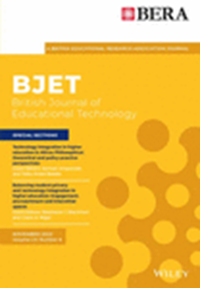GeoSolvAR: Scaffolding spatial perspective-taking ability of middle-school students using AR-enhanced inquiry learning environment
Abstract
Spatial perspective-taking (SPT) ability positively influences performance in STEM fields. While limited research studies have been done with school students, they have yielded inconclusive findings and, hence, here we report findings from our study with an augmented reality (AR) enhanced learning environment (ARELE), GeoSolvAR, on middle-school students' SPT ability. We conducted a sequential explanatory mixed-method study with 90 students to test GeoSolvAR's twin features of augmented systems and inquiry-based activities. The study had one experimental (n = 30) and two control groups (n = 30 × 2), where students were individually administered an online pre- and posttest to measure their SPT ability. The experimental group worked with both the features of GeoSolvAR, while the control group worked with only the AR feature or had no intervention. Our findings reveal that the experimental group showed significant improvement in SPT ability while students in the control groups showed non-significant improvement or no change. Furthermore, we found that all experimental group students used certain body movements and imagined shifts in spatial positions while solving the activity questions. Thus, we conjecture that GeoSolvAR affords thinking and imagining with the body which makes it a potent tool for improving students' SPT ability.
Practitioner notes
What is already known about this topic
- Spatial perspective taking (SPT) belongs to a set of spatial abilities that have been shown to positively influence academic success and career success in STEM fields.
- Augmented reality systems with their ability to augment 2D images into 3D forms are being explored mostly in college and above levels to improve SPT ability.
- Limited research investigating the improvement of SPT in school students has used VR digital games or robots. These have either yielded inconclusive findings or not found any improvement in school students' SPT abilities.
What this paper adds
- Conclusive evidence for improving SPT ability in middle-school students.
- Empirical evidence for a design to effectively combine augmenting abilities of AR systems with inquiry-based learning scaffolds to improve the SPT ability of middle-school students.
- A conjecture about the mechanism by which middle-school children's spatial perspective taking improves when scaffolded with an Augmented Reality Enhanced Learning Environment (ARELE) tool.
Implications for practice and policy
- Practitioners such as teachers may directly use GeoSolvAR (the ARELE tool) to help middle-school students improve their spatial perspective-taking abilities.
- Researchers from the fields of both technology-enhanced learning and science education may use the findings to design improved AR tools and test their impact on students' SPT ability. This work can serve as the basis for further investigating the effect of improved SPT ability on students' performance in STEM subjects.
- Our work provides support for embodied cognition being used as a strategy for solving SPT tasks. The identification of specific head and hand movements (gestures) can be further probed to understand the exact mechanism of how the ARELE mediates students' performance on the SPT tasks.


 求助内容:
求助内容: 应助结果提醒方式:
应助结果提醒方式:


